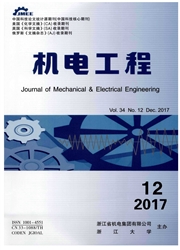

 中文摘要:
中文摘要:
针对机器人壁面上运动的稳定性问题,对永磁履带式爬壁机器人的结构特点和壁面受力进行了分析。为了便于受力分析,提出了载荷分布系数的新定义,建立了爬壁机器人的静力学模型、直线运动模型及转弯运动模型。利用Matlab软件对永磁铁吸附力、电机所需转矩、壁面倾角、载荷分布系数之间的关系,以及爬壁机器人的壁面受力进行了理论推导和数值仿真。研究结果表明,磁铁的吸附力指标主要决定于履带载荷分布系数和壁面倾角,磁铁的吸附力大小对转弯运动的灵活性有很大的影响,电机转矩要求主要决定于磁铁吸附力和壁面倾角。机器人运动模型的仿真结果与相关文献的实验结果一致,验证了运动模型的有效性,确定了影响稳定性的主要参数,给爬壁机器人的优化设计提供了依据。
 英文摘要:
英文摘要:
Aiming at the motion stability for the tracked wall-climbing robot,the characteristics of the robot and the force between the robot and wall were researched. In order to facilitate the force analysis,a new definition of load distribution coefficient of the track was proposed,the static model of linear motion and turning motion were established. The relationship between the magnetic adsorption force,wall inclination angle and the load distribution coefficient of the robot and the force between the robot and wall were simulated with Matlab software in the end. The results indicate that the requirements of adsorption force for single magnet mainly depends on the load distribution coefficient of the track and wall inclination angle,the magnet adsorption force has a great influence on the turning motion flexibility,the requirement of the motor torque mainly depend on magnetic adsorption force and wall inclination angle. The results of simulation are in good agreement with the experimental observation of related literature and the model of turning motion was confirmed,the main parameters that affect motion stability were determined,which provides the reference basis for the optimization design of the wall climbing robot.
 同期刊论文项目
同期刊论文项目
 同项目期刊论文
同项目期刊论文
 期刊信息
期刊信息
